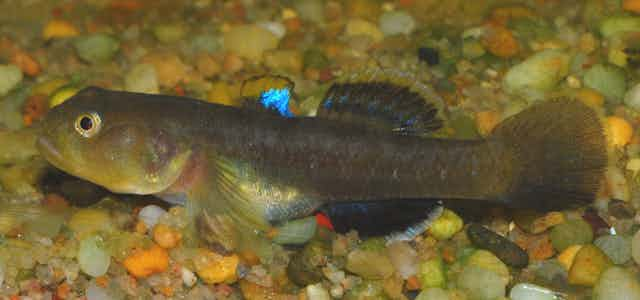Gobies are one of the largest and most widespread fish families in the world, but even so, the presence of endemic species in the Great Artesian Basin spring complexes of central Australia is a little surprising. Some of these habitats are more like damp swamps than watery oases, and many are no bigger than a kitchen table.
As a consequence, the gobies that inhabit them are small – no bigger than five or six centimetres – and have the ability to extract oxygen from the air when the springs dry back.
There are five species overall, but all are very similar and their speciation is a result of isolation in separated habitats. What this means is that the Edgbaston Goby, (Chlamydogobius squamigenus) has been ecologically marooned in the springs at Edgbaston in central western Queensland, while the Elizabeth Springs Goby, (Chlamydogobius micropterus) has similarly been stuck at Elizabeth Springs 400-plus kilometres to the south-west. Other relatives are distributed through South Australia and the Northern Territory.
Although they have different names and live in different localities, the various central Australian gobies have much in common. The males are vividly coloured, with a noticeable blue, black and white splash on their dorsal fins.
The males also guard the clutches of eggs, circulating water over them with their fins and tails until they hatch. And, like all gobies, they spend the majority of the time resting on the fused fins on their underside.
Status
Both goby species found in springs in Queensland are listed as critically endangered by the IUCN and endangered under Queensland legislation. Under the federal EPBC Act the Elizabeth Springs Goby is listed as endangered and the Edgbaston Goby is listed as vulnerable.

Threats
All gobies (and also all the other endemic plants and animals from Great Artesian Basin springs) are threatened by aquifer drawdown (from extractive water use) and the disruption and destruction from feral and domestic animals.
The Edgbaston Goby is also under threat from the introduced live-bearing fish Gambusia or Mosquitofish which is also present in the springs at Edgbaston.
Strategy
The spring complex at Edgbaston was purchased by the conservation not-for-profit Bush Heritage Australia, and the spring complex at Elizabeth Springs is a national park. This affords Queensland’s endangered spring gobies a measure of protection as these organisations do their best to keep stock and feral animals away from the fragile spring habitats.
At Edgbaston, Bush Heritage Australia has also been developing techniques to control Gambusia, which is also helping the critically endangered Red-finned Blue-eye.
Conclusion
Both Elizabeth Springs Goby and Edgbaston Goby rightfully deserve listing as endangered species due to their limited ranges and specific habitat requirements.
At present, the Edgbaston Goby is under more direct threat than Elizabeth Springs Goby. This is thanks to Gambusia that are found in massive numbers in some of the springs where they have invaded. Observations over the last five years suggest that as Gambusia populations increase, goby populations decrease – a similar situation to the competition and exclusion of Red-finned Blue-eye.
The Conversation is running a series on Australian endangered species. See it here

